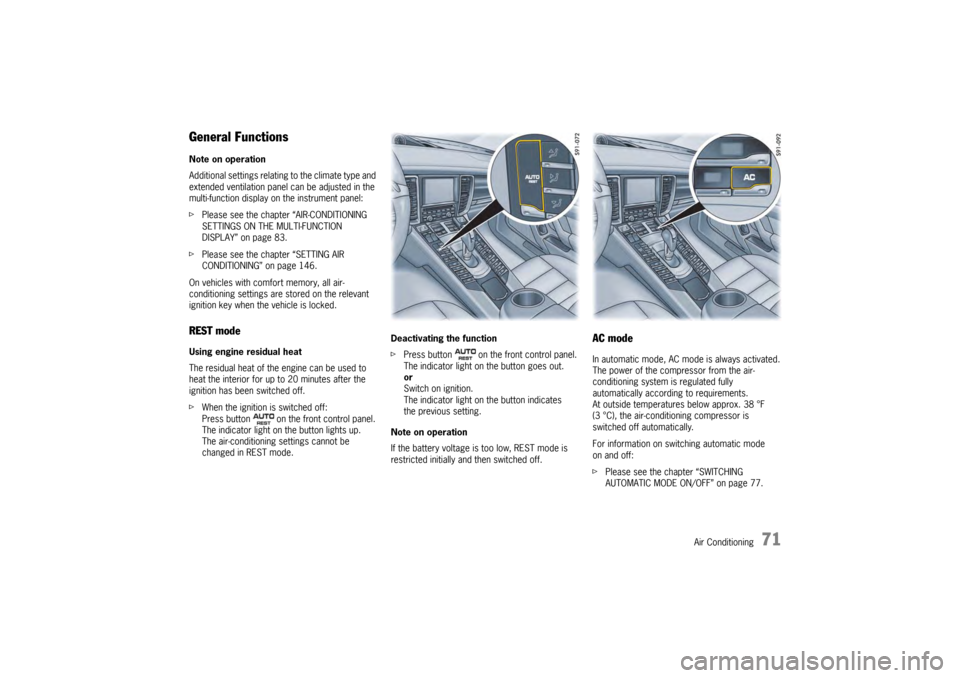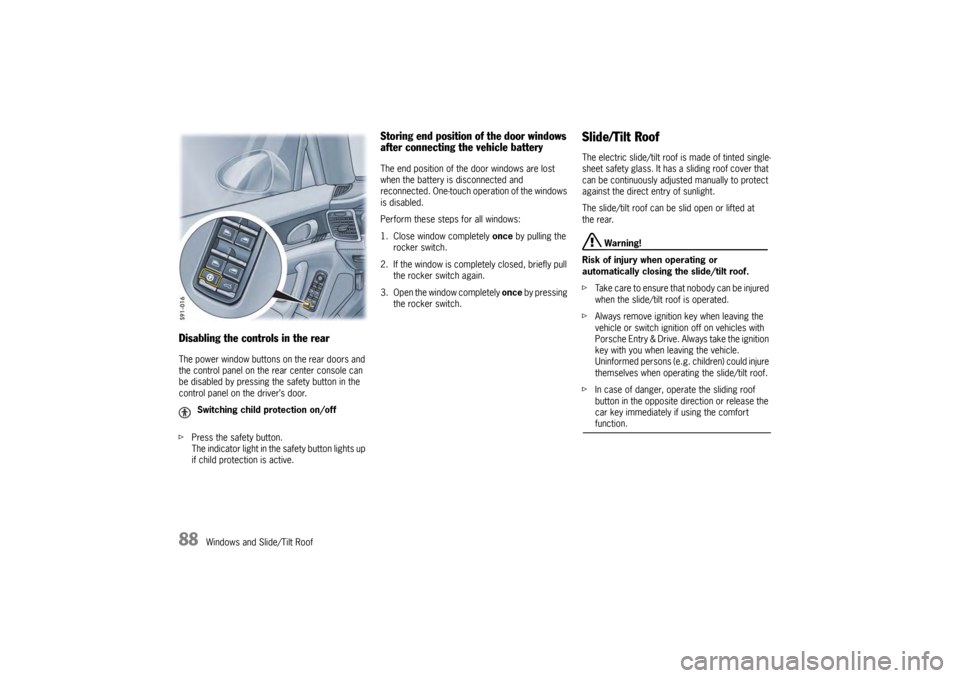2009 PORSCHE PANAMERA battery
[x] Cancel search: batteryPage 6 of 343

4Dear Porsche Owner,A lot has gone into the manufacture of your
Porsche, including advanced engineering, rigid
quality control and demanding inspections. These
engineering and safety features will be enhanced
by you…the safe driver…– who knows her/his car and all controls,
– who maintains the vehicle properly,
– who uses driving skills wisely and always drives within her/his own capabilities and the
level of familiarity with the vehicle.
You will find helpful hints in this manual on how to
perform most of the checks listed on the following
pages. If in doubt, have these checks performed
by your authorized Porsche dealer.
Before driving off…Check the following items firstf Turn the engine off before you attempt any
checks or repairs on the vehicle.
f Be sure the tires are inflated correctly.
Check tires for damage and tire wear.
f See that wheel bolts are properly tightened
and not loose or missing.
f Check engine oil level, add if necessary. Make
it a habit to have engine oil checked with every
refueling.
f Check all fluid levels such as windshield
washer and brake fluid levels.
f Be sure the vehicle battery is well charged and
cranks the engine properly.
f Check all doors and lids for proper operation
and latch them properly.
f Check and if necessary replace worn or
cracked wiper blades.
f See that all windows are clear and unobst-
ructed.
f Check air intake slots and area between
engine compartment lid and windshield.
Ensure that these areas are free of snow and
ice, so the heater and the windshield wipers
work properly. f
If a child will be riding in the vehicle, check
child seat/child seat restraint system to ensure
that restraints are properly adjusted.
f Check all exterior and interior lights for opera-
tion and that the lenses are clean.
f Check the headlights for proper aim, and if
necessary, have them adjusted.
f Check under the vehicle for leaks.
f Be sure all luggage is stowed securely.
Emergency equipmentIt is good practice to carry emergency equipment
in your vehicle.
Some of the items you should have are: window
scraper, snow brush, container or bag of sand or
salt, emergency light, small shovel, first-aid kit,
etc.
Page 9 of 343

Contents
7
Contents
Overview Illustrations......................... 10Driver’s Cockpit ...............................
............. 11
Steering Wheel and Inst rument Panel .............. 12
Dashboard .......................................... ......... 13
Front Center Console . ................................... 14
Overhead Operating Co nsole ......................... 15
Rear ............................................................ 16Opening and Locking ......................... 17Never invite car theft! . ................................... 18
Notes on the Key and Central Locking
System ......................... .............................. 19
Central Locking System ................................ 20
Brief Overview – Opening and Locking
From Outside................................... ............. 21
Opening and Locking From Outside ................ 22
Opening and Locking From Inside................... 31
Opening and Closing the Engine
Compartment Lid ........ .................................. 33
Malfunctions When Open ing and Closing ......... 35Seats, Mirrors and Steering Wheel ..... 37Seat Adjustment and Head Restraints ............. 38
Adjusting Front Seats . ................................... 39
Storing Vehicle Settin gs ................................ 40
Easy Entry Function .... .................................. 42
Adjusting Rear Seats ..................................... 42
Adjusting Passenger Seat From Rear.............. 43
Front and Rear Heated Seats ......................... 43
Front and Rear Seat Ventilation ...................... 44 Safety Belts..............
.................................... 44
Air bag Systems ....... .................................... 47
Child Restraint System s................................. 52
LATCH Child Seat Syst em.............................. 56
Exterior Mirrors ........ .................................... 58
Steering Wheel ......... .................................... 61
Heated steering whee l ................................... 61
Steering Wheel Adjust ment ............................ 62
Multi-Function Steering Wheel......................... 63
Sun Visors .................... ................................ 64
Vanity Mirror ............. .................................... 64
Roll-Up Sunblinds, Rear Side Windows ............ 65
Roll-Up Sunblind, Rear Window ....................... 66
Air Conditioning .... ............................ 67Brief Overview – Front Control Panel ........ 68
Brief Overview – Rear Control Panel
(4-Zone Air-Conditioning) ................................ 69
Overview of Air Conditioning .......................... 70
General Functions ..... .................................... 71
Automatically Controlled Air Conditioning ........ 76
Air Vents ........................................... ........... 82
Heated Rear Window/Exterior Mirror
Heating ............................................. ........... 84Windows and Slide/Tilt Roof............... 85Power Windows ............................................ 86
Slide/Tilt Roof........... .................................... 88
Lights, Turn Signals and
Windshield Wipers. ............................ 91Automatic Driving Light Assistant/
Adaptive Light System ................................... 92
Instrument lighting ....... ................................. 95
Turn Signal/High Beam/Headlight
Flasher Stalk........... ...................................... 96
Emergency Flasher ...... ................................. 97
Interior Lighting............................ ................. 98
Brief Overview – Windshield Wipers ............ 101
Windshield Wiper/Washer Stalk .................... 102Instrument Panel and
Multi-Function Display ..................... 105Instrument Panel USA Mo dels ...................... 107
Instrument Panel Canada Models.................. 109
Tachometer ..................... ........................... 110
Speedometer .................. ........................... 110
Multi-Function Display .................................. 110
Engine Oil Temperature Gauge ..................... 110
Coolant Temperature Gauge ........................ 110
Engine Oil Pressure Ga uge .......................... 111
Fuel Gauge .................. ............................... 111
Digital Speedometer .... ............................... 112
Upshift Prompt Indicato r .............................. 112
Odometer........................ ........................... 112
Reset Button for Trip Counter Display/
Brightness Setting for In strument Lighting.... 112
PDK Display for Selector-Lever Position/
Engaged Gear ................. ........................... 112
Battery/Alternator ........ ............................... 113
Page 11 of 343

Contents
9
Battery....................................................... 303
External Power Supply, Jump-Lead
Starting...................... ................................ 306
Changing the Remote Control Battery ........... 307
Replacing Bulbs .......... ................................ 308
Headlights ...................... ............................ 308
Side Turn Signal Ligh t ................................. 312
Licence Plate Lights .... ................................ 313
Side Marker Light ... .................................... 313
Changing Light-Emitting Diodes and
Long-Life Bulbs ........... ............................... 314
Headlight Adjustment .. ................................ 314
Towing ....................................................... 316
Fire Extinguisher ......... ................................ 321Tire Pressure and Technical Data ..... 322Vehicle Identification Data ............................ 323
Engine Data................................................ 324
Wheels, Tires.............. ................................ 325
Tire Pressure for Cold Tires (68 °F/20 °C) .... 326
Weights...................................................... 328
Filling Capacities ......... ................................ 329
Driving Performance ... ................................ 329
Dimensions .................... ............................ 330Index .............................................. 331
Page 32 of 343

30
Opening and Locking
Detection of obstacles during closing Warning!
Danger of crushing.
f Despite the presence of this detection system,
you are still responsible for keeping yourself
and others entirely out of the way of the door as it is closing.
The closing operation is interrupted if closing
of the tailgate is blocked by an obstacle.
A warning signal sounds and the tailgate opens
again.
When the obstacle has been removed, the tailgate
can be closed by pressing the button in the
tailgate trim panel.
Automatic stop in the event of unintentional
tailgate movement
If the tailgate is moved too abruptly or lowers
unaided immediately after opening, e.g. due to
the weight of snow, an electrical mechanism
brakes the tailgate and a series of brief warning
signals sounds until the tailgate stops moving.
f Bring the tailgate to rest for approx. 1 second.
The braking function is deactivated. Adjusting the opening height of the tailgate
The opening height of the tailgate can be
individually adjusted so
that the tailgate does not
collide with the garage ceiling, for example.
On vehicles with level control, the vehicle height
changes according to the level control setting.
f Always adjust the opening height with the
vehicle at the highest level setting so that the
tailgate cannot accidentally collide with the
garage ceiling, for example.
Caution!
Risk of damage to the tailgate. If the luggage
compartment cover is not attached to the
tailgate, the tailgate continues to move
slowly upwards beyond the automatic stop.
f Only use the powerlift tailgate with the luggage compartment cover attached.
1. Stand behind the vehicl e and open the tailgate.
2. Press button on the key to stop the automatic opening operation at around 2/3
of the opening height.
3. Now move the tailgate up by hand until the desired opening height is reached. Make sure
that there is a sufficient minimum clearance
from any obstacle. 4. Press the button
A in the trim panel on the
tailgate for approximately 3 seconds.
An acknowledgement signal sounds.
The opening height of the tailgate has now
been programmed.
The tailgate can now be closed by briefly
pressing the button.
This setting cannot be deleted. If a different
setting is required, repeat steps 1 to 4.
Malfunctions of the tailgate drive
The automatic function is not active if the battery
voltage is too low.
If a button is pressed, th e tailgate lock is unlocked
and three brief warning sign als sound. The tailgate
can now be opened by hand.
f Charge the vehicle battery.
Emergency operation of tailgate
If the automatic opening or closing operation is
interrupted by a fault:
f Slowly open or close the tailgate by hand.
Overload protection
If overloading of the tailgate drive is detected,
three brief warning signals sound.
The tailgate cannot be operated automatically
for approx. 30 seconds.
Page 37 of 343

Opening and Locking
35
Malfunctions When Opening and
ClosingEmergency operation of tailgateIf the tailgate cannot be opened with the radio
remote control (e.g. if th e battery of the remote
control is dead), the emergency operation must
be performed:
1. Unlock and open the driver’s door with the car key.
2. Switch on the ignition within 10 seconds to prevent the alarm system from
triggering.
3. Press the central locking button on the front or rear center console.
The tailgate is now unlocked and can be
opened with the unlocking handle.
Only one door is unlockedOn the multi-function di splay in the instrument
panel, you can set different variants for locking
and unlocking the doors and tailgate. You can
open all doors irrespective of the setting made.
f Press button on the key twice within
2seconds.The vehicle cannot be unlockedThe remote control of the key may
– not function correctly due to radio waves (also
radio contact between remote control and
vehicle in the case of Porsche Entry & Drive),
– fail due to a fault,
– fail due to a flat key battery.
f Unlock the vehicle using the emergency key
in the door lock.
If the vehicle was unlocked using the
emergency key in the door lock, only the
driver’s door can be opened.
In order to prevent the alarm system from
being triggered, switch the ignition on
within 10 seconds of opening the door .
The vehicle cannot be lockedThis is recognizable by the fact that the
emergency flasher does not flash and there is no
locking noise.
The remote control of the key may
– not function correctly due to radio waves (also radio contact between remote control
and vehicle in the case of Porsche Entry &
Drive),
– fail due to a fault,
– fail due to a flat key battery.
f Lock the vehicle usin g the emergency key
in the door lock.
If the central locking system is defective,
operating the lock cylinder in the driver’s door will
lock all functioning lockin g elements of the central
locking system.
For information on lockin g the doors by means of
the emergency operation:
f Please see the chapter “NOT ALL VEHICLE
DOORS ARE LOCKED” on page 36.
f Have faults in the central locking system
repaired.
Please contact a qualified specialist workshop.
We recommend that you have an authorized
Porsche dealer to do this work as they have
trained workshop personnel and the necessary
parts and tools.
Page 73 of 343

Air Conditioning
71
General FunctionsNote on operation
Additional settings relating to the climate type and
extended ventilation panel can be adjusted in the
multi-function display on the instrument panel:
f Please see the chapter “AIR-CONDITIONING
SETTINGS ON THE MULTI-FUNCTION
DISPLAY” on page 83.
f Please see the chapter “SETTING AIR
CONDITIONING” on page 146.
On vehicles with comfort memory, all air-
conditioning settings are stored on the relevant
ignition key when the vehicle is locked.REST modeUsing engine residual heat
The residual heat of the engine can be used to
heat the interior for up to 20 minutes after the
ignition has been switched off.
f When the ignition is switched off:
Press button on the front control panel.
The indicator light on the button lights up.
The air-conditioning settings cannot be
changed in REST mode. Deactivating the function
f
Press button on the front control panel.
The indicator light on the button goes out.
or
Switch on ignition.
The indicator light on the button indicates
the previous setting.
Note on operation
If the battery voltage is too low, REST mode is
restricted initially and then switched off.
AC modeIn automatic mode, AC mode is always activated.
The power of the compressor from the air-
conditioning system is regulated fully
automatically according to requirements.
At outside temperatures below approx. 38 °F
(3 °C), the air-conditioning compressor is
switched off automatically.
For information on switching automatic mode
on and off:
f Please see the chapter “SWITCHING
AUTOMATIC MODE ON/OFF” on page 77.
Page 77 of 343

Air Conditioning
75
Setting automatic air-recirculation modeIn automatic air-recirculation mode, the fresh air
supply is adjusted depending on the air quality.
Automatic air-recirculation mode can be switched
on and off on the multi-function display.
At outside temperatures below approx. 50 °F
(10 °C), air-recirculation mode is deactivated
automatically to prevent the windows from
misting.
For information on adjusting automatic air-
recirculation mode on the multi-function display:
fPlease see the chapter “SETTING AIR
CONDITIONING” on page 146.
Note
The recommended operating mode is automatic
air-recirculation mode (default setting).
Information on the air-conditioning
compressorThe air-conditioning compressor:
– Can switch off briefly to ensure sufficient engine cooling if the engine is operating under
extreme load.
– Automatically switches off at temperatures below 38 °F (3 °C) and cannot be switched on,
even manually.
– Operates most effectively with the windows closed.
If the vehicle has been in the sun for a long
time, it is a good idea to ventilate the interior
briefly with the windows open.
– Depending on the outside temperature and humidity, condensation can drip from the
evaporator and form a pool under the vehicle.
This is normal and not a sign of leaks.
Information on automatic load switch-offIf the charging condition of the battery is critical,
the following air-conditioning or heating functions
are restricted initially and then switched off.
– Heated seats
– Heated rear window/External mirror heating
–Fresh-air blower
– Air-conditioning compressor
Page 90 of 343

88
Windows and Slide/Tilt Roof
Disabling the controls in the rearThe power window buttons on the rear doors and
the control panel on the rear center console can
be disabled by pressing the safety button in the
control panel on the driver’s door.
fPress the safety button.
The indicator light in the safety button lights up
if child protection is active.
Storing end position of the door windows
after connecting the vehicle batteryThe end position of the door windows are lost
when the battery is disconnected and
reconnected. One-touch operation of the windows
is disabled.
Perform these steps for all windows:
1. Close window completely once by pulling the
rocker switch.
2. If the window is comple tely closed, briefly pull
the rocker switch again.
3. Open the window completely once by pressing
the rocker switch.
Slide/Tilt RoofThe electric slide/tilt roof is made of tinted single-
sheet safety glass. It has a sliding roof cover that
can be continuously adjusted manually to protect
against the direct entry of sunlight.
The slide/tilt roof can be slid open or lifted at
the rear.
Warning!
Risk of injury when operating or
automatically closing the slide/tilt roof.
f Take care to ensure that nobody can be injured
when the slide/tilt roof is operated.
f Always remove ignition key when leaving the
vehicle or switch ignition off on vehicles with
Porsche Entry & Drive. Always take the ignition
key with you when leaving the vehicle.
Uninformed persons (e.g. children) could injure
themselves when operating the slide/tilt roof.
f In case of danger, operate the sliding roof
button in the opposite di rection or release the
car key immediately if using the comfort function.
Switching child protection on/off